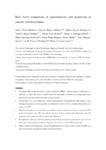Mostrar o rexistro simple do ítem
Real World Comparison of Spironolactone and Eplerenone in Patients With Heart Failure
| dc.contributor.author | Pardo-Martínez, Patricia | |
| dc.contributor.author | Barge-Caballero, Eduardo | |
| dc.contributor.author | Bouzas-Mosquera, Alberto | |
| dc.contributor.author | Barge-Caballero, Gonzalo | |
| dc.contributor.author | Couto-Mallón, David | |
| dc.contributor.author | Paniagua-Martín, María J. | |
| dc.contributor.author | Sagastagoitia-Fornie, Marta | |
| dc.contributor.author | Prada-Delgado, Óscar | |
| dc.contributor.author | Muñiz, Javier | |
| dc.contributor.author | Almenar-Bonet, Luis | |
| dc.contributor.author | Vázquez Rodríguez, José Manuel | |
| dc.contributor.author | Crespo-Leiro, María Generosa | |
| dc.date.accessioned | 2022-02-18T11:20:22Z | |
| dc.date.issued | 2022-01-06 | |
| dc.identifier.citation | Pardo-Martínez P, Barge-Caballero E, Bouzas-Mosquera A, Barge-Caballero G, Couto-Mallón D, Paniagua-Martín MJ, et al. Real world comparison of spironolactone and eplerenone in patients with heart failure. Eur J Intern Med.2022;97:86-94 | es_ES |
| dc.identifier.issn | 0953-6205 | |
| dc.identifier.uri | http://hdl.handle.net/2183/29814 | |
| dc.description.abstract | [Abstract] Aims. In the absence of previous direct comparative studies, we aimed to evaluate the effectiveness of spironolactone and eplerenone in patients with heart failure and reduced ejection fraction (HFrEF) in a real-world clinical setting. Methods. Using Fine-Gray´s competing risk regression, we compared the clinical outcomes of 293 patients with chronic HF and left ventricular ejection fraction <40% treated with eplerenone and 293 propensity-score matched individuals treated with spironolactone. Study subjects were selected from a prospective cohort of 1404 ambulatory patients with HFrEF seen since 2010 to 2019 in a single specialized HF clinic, among which 992 received a mineralocorticoid receptor antagonist at baseline. Median follow-up was 3.95 years. Results. No statistically significant differences between patients treated with eplerenone versus spironolactone were observed with regard to the risk of the primary composite end-point cardiovascular death or HF hospitalization (HR 0.95; 95% CI 0.73–1.23; p= 0.677). However, eplerenone use was associated to lower cardiovascular mortality (HR 0.55; 95% CI 0.35–0.85; p= 0.008) and lower all-cause mortality (HR 0.67; 95% CI 0.47–0.95; p= 0.027). The incidence of drug suspension due to side effects (HR 0.58, 95% CI 0.40–0.85; p= 0.005) and drug suspension due to any reason (HR 0.70, 95% CI 0.51–0.97; p= 0.033) were lower among patients treated with eplerenone. Conclusions. In this observational, real-world, propensity-score matched study of patients with HFrEF, eplerenone was associated to lower cardiovascular mortality and lower all-cause mortality than spironolactone. | es_ES |
| dc.language.iso | eng | es_ES |
| dc.publisher | Elsevier | es_ES |
| dc.relation.uri | https://doi.org/10.1016/j.ejim.2021.12.027 | es_ES |
| dc.rights | Creative Commons Attribution-NonCommercial-NoDerivs 4.0 International Licence (CC-BY-NC-ND 4.0) | es_ES |
| dc.rights.uri | http://creativecommons.org/licenses/by-nc-nd/4.0/ | * |
| dc.subject | Heart failure | es_ES |
| dc.subject | Reduced ejection fraction | es_ES |
| dc.subject | Spironolactone | es_ES |
| dc.subject | Eplerenone | es_ES |
| dc.subject | Survival | es_ES |
| dc.subject | Outcomes | es_ES |
| dc.title | Real World Comparison of Spironolactone and Eplerenone in Patients With Heart Failure | es_ES |
| dc.type | journal article | es_ES |
| dc.rights.accessRights | embargoed access | es_ES |
| dc.date.embargoEndDate | 2023-01-06 | es_ES |
| dc.date.embargoLift | 2023-01-06 | |
| UDC.journalTitle | European Journal of Internal Medicine | es_ES |
| UDC.coleccion | Investigación | es_ES |
| UDC.departamento | Ciencias da Saúde | es_ES |
| UDC.grupoInv | Grupo de Investigación Cardiovascular (GRINCAR) | es_ES |
Ficheiros no ítem
Este ítem aparece na(s) seguinte(s) colección(s)
-
Investigación (FEP) [504]







